Service discovery platform for ubiquitous environments
DOI:
https://doi.org/10.17533/udea.redin.14618Keywords:
ubiquitous environments, services retrieval, algorithmAbstract
The capability to easily fi nd useful services in ubiquitous environments becomes increasingly critical in several application domains. Current approaches for ubiquitous services retrieval are mostly limited to the matching of their inputs/outputs possibly enhanced with some ontological knowledge. Recent research has demonstrated that this approach is not suffi cient to discover relevant services. Motivated by these concerns, this work proposes a service discovery platform in ubiquitous environments based on behavior matchmaking. We argue that in many situations the service composition process requires a service discovery phase based on matchmaking of behavior specifi cations of the components. Consequently, even if a service that meets exactly the user requirements does not exist, the most similar ones will be retrieved.
Downloads
References
E. S. Abdur-Rahman, J. Black. “Semantic-based context-aware service discovery in pervasivecomputing environments”. Proceedings of 1st IEEE Workshop on Service Integration in Pervasive Environments. Lyon. France. 2006. pp. 9-14.
J. C. Corrales, D. Grigori, M. Bouzeghoub. “BPEL Processes Matchmaking for Service Discovery”. M. Papazoglou, L. Raschid, R. Ruggaber (editors) Proceedings of the 4th International Conference on Cooperative Information Systems (CoopIS 2006). Montpellier. France. October 29 - November DOI: https://doi.org/10.1007/11914853_15
2006. pp. 237-254. 3. A. Bandara, T. Payne, D. De Roure, T. Lewis. A Semantic Approach for Service Matching in Pervasive Environments. Reporte Técnico. Universidad de Southampton. Southampton (UK). 2007. pp 1-5.
J. C. Corrales. Behavioral matchmaking for service retrieval. Ph.D.Tesis. University of Versailles SaintQuentin-en-Yvelines. Versailles (France). 2008. pp 26- 44.
M. Sellami, S. Tata, B. Defude. Service Discovery in Ubiquitous Environments: Approaches and Requirement for Context-Awareness. Advances in Semantics for Web services Workshop. Ed. BPM Workshops. Vol 17. 2008. Milan (Italy). 2008. pp. 516- 522. DOI: https://doi.org/10.1007/978-3-642-00328-8_52
L. Steller, S. Krishnaswamy. “Effi cient Mobile Reasoning for Pervasive Discovery”. Proc of the 2009 ACM symposium on Applied Computing. Honolulu (Hawaii). March 9-12. 2009. pp. 1247-1251. DOI: https://doi.org/10.1145/1529282.1529562
Y. Zhang, B. Liu, H. Wang. “A Method of Web Service Discovery based on Semantic Message Bipartite Matching for Remote Medical System”. Journal of Theoretical and Applied Electronic Commerce Research. Vol. 4. 2009. pp. 79-87. DOI: https://doi.org/10.4067/S0718-18762009000200007
G. H. T. Sayed, M. Wan, I. Suhaimi, V.D. Amir. “Integrating Discovery and Composition of Semantic Web Services Based on Description Logic”. Journal of Computer Science, Informatics & Electrical Engineering. Vol. 3. 2009. pp. 1-12.
A. Bernstein, M. Klein. “Towards high-precision service retrieval”. Proceedings of ISWC, LNCS. Sardinia (Italia). June 9-12. 2002. Vol. 2342. 2002. pp. 84-101. DOI: https://doi.org/10.1007/3-540-48005-6_9
A. Wombacher, B. Mahleko, P. Fankhauser, E. Neuhold. “Matchmaking for business processes based on choreographies”. Proceedings of IEEE Computer Society. February 19-20.2004. Washington DC. (USA). 2004. pp. 359-368. DOI: https://doi.org/10.1109/EEE.2004.1287334
J. C. Corrales, D. Grigori, M. Bouzeghoub, J. E. Burbano. “Bematch: A platform for matchmaking service behavior models”. Proceedings of EDBT. ACM International Conference Proceeding. Series 261. Nantes (France). 2008. pp. 695-699. DOI: https://doi.org/10.1145/1353343.1353428
G. Hackmann, C. Gill, G. C. Roman. “Extending BPEL for interoperable pervasive computing”. Proceedings. of ICPS. IEEE Computer Society Press. Istanbul (Turkey). 2007. pp. 204-213. DOI: https://doi.org/10.1109/PERSER.2007.4283918
J. Vanhatalo, J. Koehler, F. Leymann. “Repository for business processes and arbitrary associated metadata”. Proceedings of the BPM Demo Session at the Fourth International Conference on Business Process Management. Viena (Austria). 2006. pp. 25-31.
Wireless Application Protocol Forum, WAG UAProf version 20-Oct-2001. http://www.wapforum.org/. 2001. Consultada el 7 de octubre de 2009.
L. Passani, http://wurfl.sourceforge.net/. Consultada el 7 de octubre de 2009.
J. Mendling, J. Ziemann. “Transformation of bpel processes to epcs”. Proceedings of EPK. Hamburg (Germany). Vol. 167. 2005. pp. 41-53.
R. C. Angell, G. Freund, P. Willett. “Automatic spelling correction using a trigram similarity measure”. Information Processing and management. Vol. 19. 1983. pp. 255-261. DOI: https://doi.org/10.1016/0306-4573(83)90022-5
G. Miller. “Wordnet: A lexical database for English”. Communications of the ACM. Vol. 38. 1995. pp. 39-41. DOI: https://doi.org/10.1145/219717.219748
M. J. Spendolini. Benchmarking. Ed. Amacon. New York (USA). 1994. pp. 3-50.
Y. Zhang, X. Dong, A. Halevy, J. Madhavan, E. Nemes. “Similarity Search for Web Services”. Proceedings of the 30th VLDB conference. Toronto (Canada).Vol. 30. 2004. pp. 372–383. DOI: https://doi.org/10.1016/B978-012088469-8.50035-8
D. Lewis. Representation and learning in information retrieval. Ph.D. Thesis. Department of Computer and Information Science. University of Massachusetts. Massachusetts (USA). 1992. pp. 28-35.
Downloads
Published
How to Cite
Issue
Section
License
Copyright (c) 2018 Revista Facultad de Ingeniería

This work is licensed under a Creative Commons Attribution-NonCommercial-ShareAlike 4.0 International License.
Revista Facultad de Ingeniería, Universidad de Antioquia is licensed under the Creative Commons Attribution BY-NC-SA 4.0 license. https://creativecommons.org/licenses/by-nc-sa/4.0/deed.en
You are free to:
Share — copy and redistribute the material in any medium or format
Adapt — remix, transform, and build upon the material
Under the following terms:
Attribution — You must give appropriate credit, provide a link to the license, and indicate if changes were made. You may do so in any reasonable manner, but not in any way that suggests the licensor endorses you or your use.
NonCommercial — You may not use the material for commercial purposes.
ShareAlike — If you remix, transform, or build upon the material, you must distribute your contributions under the same license as the original.
The material published in the journal can be distributed, copied and exhibited by third parties if the respective credits are given to the journal. No commercial benefit can be obtained and derivative works must be under the same license terms as the original work.










 Twitter
Twitter